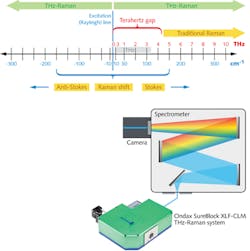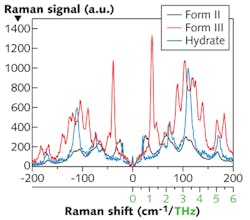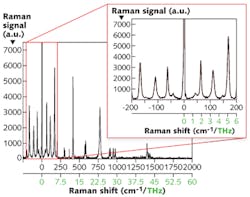SPECTROSCOPY: Terahertz Raman: Accessing molecular structure with Raman spectroscopy
JAMES CARRIERE and RANDY HEYLER
Raman spectroscopy has rapidly gained acceptance as an invaluable tool for detecting, quantifying, and analyzing the chemical composition of materials across a broad range of industries. From pharmaceuticals to narcotics and explosives detection, to cancer pathology and basic material science, Raman spectroscopy has enabled faster, easier, less expensive, more compact, and even portable spectral analysis for an ever-broadening list of applications.
Extending Raman beyond chemical and into structural analysis, however, has been limited primarily due to detection efficiency and expense. Molecular structure is increasingly important as many molecules can exist in different or "polymorphic" forms that can significantly impact their chemical, optical, and electromechanical properties. Examples include pharmaceuticals, where therapeutic efficacy and bio-availability are strongly driven by the molecular structure; or simple carbon, which can exhibit radically different properties when arranged in the form of a pencil lead, diamond crystal, graphene sheet, or nanotube.
Today, structural chemistry is principally the domain of x-ray diffraction (XRD), Fourier transform infrared (FTIR), and terahertz absorption spectroscopy. Unfortunately, these techniques can be destructive, expensive, and/or require large sample sizes and preparation, and in some cases are further limited by physical form of the sample (gas, liquid, or solid) or experimental conditions (such as the presence of moisture or air). Raman spectroscopy, on the other hand, is inherently nondestructive, noninvasive, works with trace amounts of any substance in nearly any lab or field environment, and requires no sample preparation.
The problem has been to extend the reach of Raman—in an efficient and cost-effective way—into the spectral regime where important structural details (including lattice or polymer structures, crystal orientation, spin waves, and phonon modes) can be discerned. These characteristics are normally correlated to low-energy molecular transitions and vibrations that occur on approximately 0.1 to 10 ps timescales and exhibit spectra in the approximately 0.3 to 3.0 THz or 10 cm-1 to 100 cm-1, also known as the "terahertz" (THz) or "low-frequency Raman" regime to spectroscopists.
Extending terahertz-Raman reach
The terahertz range has been largely inaccessible for traditional Raman spectrometers due to limitations in edge or notch filters used to block out the Rayleigh backscatter from the excitation laser. Multistage spectrometers that can more precisely block Rayleigh scatter and provide access to this region are much larger and more expensive, and also reduce signal strength by more than an order of magnitude. But recent developments in the area of ultranarrowband filters and wavelength-stabilized lasers have resulted in a new, affordable, and easy-to-use tool for extending Raman system performance into this ultralow-frequency terahertz-Raman or "THz-Raman" domain-bringing structural analysis within reach for anyone with a standard Raman system (see Fig. 1).1
Many commercially available Raman systems are generally limited to the spectral region starting from approximately 150 cm-1 (4.5 THz) and can extend to more than 90 THz (3000 cm-1). Both wavelength range and resolution are primarily dependent on the configuration of the gratings and detector elements, and are inversely proportional; that is, higher resolution generally limits overall wavelength range and vice versa. These systems are well suited to examining higher-energy molecular transitions (for chemical composition), with sufficiently broad range and moderate resolution (approximately 5 to 10 cm-1 or 150-300 GHz, respectively).
The edge or notch filters used to block Rayleigh scattered light will normally have fairly broad transition widths less than 50 cm-1 (1.5 THz) and end up removing most or all of the low-frequency (less than 100 cm-1) signals. But THz-Raman systems, by contrast, use ultranarrowband notch filters comprising volume holographic gratings (VHGs). These VHGs are extremely robust "solid-state" gratings produced in a photosensitive glass, giving them all the transmission properties of optical glass, yet extremely high diffraction efficiency (or reflectivity) over a very narrow wavelength range.
Ondax VHG notch filters have an optical density greater than 4.0 at the excitation laser wavelength, with an exceptionally sharp transition width that is a full order of magnitude narrower than conventional thin-film edge filters: Signals less than 10 cm-1 away show little attenuation, while throughput remains as high as 90% for larger shifts.2 This leads to essentially no performance tradeoff across the Raman spectrum, making VHGs an all-purpose solution for THz-Raman spectroscopy.
However, in order to achieve optimal system-level performance, attention must be paid to laser and spectrometer specifications and overall optical layout. Because of the ultranarrowband filter performance, laser excitation sources must have extremely narrow, stable linewidths, and be free of amplified spontaneous emission (ASE) noise that can be comparable to (or even orders of magnitude larger than) the Raman signals of interest.
In the case of diode or diode-pumped lasers, closely matched ultranarrowband ASE filters (also made from VHGs) are required. And to preserve system throughput, careful attention to optics is critical. For example, using a 90/10 VHG-based narrowband beamsplitter can significantly boost overall system output (see Fig. 2).The single-stage spectrometer should be configured to have sufficient spectral resolution to observe the low-energy transitions of interest for the specific material under test. For most applications, this will require system resolution on the order of 1 cm-1 (30 GHz) to have sufficient data over the entire terahertz regime. A conventional single-stage spectrometer with more than 300 mm focal length and a 1200–1800 lines/mm grating will typically provide spectral resolution on this order. It should be noted that simply increasing the pitch of the dispersive grating inside the spectrometer will not always improve spectral resolution, as it can lead to increased aberrations in the beam that will degrade the effective resolution.
THz-Raman vs. traditional terahertz
The THz-Raman spectroscopy method is not necessarily a substitute for other structural analysis techniques but plays a complementary role, and it has several notable differences in how it works and where it works best.
As a brief comparison, traditional terahertz spectroscopy systems (whether time-domain or frequency domain) use "absorption" methods whereby radiation is generated and emitted in the 100 GHz to approximately 3 THz frequency range and the corresponding absorption spectrum is detected. Terahertz radiation can often penetrate coatings and containers to analyze underlying substances (a significant benefit), although it has limited spectral range and output power and typically requires relatively expensive tunable or ultrafast laser sources. Limitations in detector and wideband multi-octave antenna performance further restrict the potential sensitivity, resolution, and/or economics of using this technique. In addition, the presence of strong absorption lines from water often requires careful sample preparation in order to maintain sensitivity over the entire range. These factors have conspired to inhibit the widespread adoption of terahertz spectroscopy.
Alternatively, THz-Raman spectroscopy is a "reflection" or scattering technique that is not susceptible to water vapor, requires little-to-no-sample preparation, can use compact, less expensive wavelength-stabilized diode lasers, and can work at standoff distances. Raman scattering, however, is an inherently weak process; not all materials scatter well in this regime and sample fluorescence can often be a problem that requires careful selection of excitation wavelength. So although THz-Raman is generally more versatile and affordable, inevitably the application requirements ultimately determine the best technique.
THz-Raman spectroscopy has potential to improve efficiency and reduce the cost of structural analysis, trace detection, or basic research. Examples include polymorphic structure identification of active pharmaceutical ingredients for R&D and process control; trace detection and forensic analysis of explosive and hazardous materials; pathology of cancer cells; forensic analysis of art, gems, and counterfeit items; solar, battery, and organic semiconductor material characterization; petroleum and plastics characterization; detection and analysis of radioactive isotopes, heavy metal compounds, and nano- and biomaterials; and in situ measurement of temperature in optically pumped gas cells.3-5
Experimental results
One of the most important applications for THz-Raman systems is polymorph identification, which plays a critical role in pharmaceuticals. One example is carbamazepine, an anticonvulsant drug used in the treatment of epilepsy and bipolar disorder. With four distinct anhydrous polymorphs, only form III is used commercially.6 Traditional means of characterizing the different forms include FTIR spectroscopy, x-ray powder diffraction (XRPD), and differential scanning calorimetry (DSC). But THz-Raman analysis can quickly and clearly differentiate the various forms as well as the hydrate structure of these polymorphs (see Fig. 3).The areas from 20 to 60 cm-1 and 80 to 140 cm-1 show dramatic differences between the different samples that can easily be used for identification. An additional benefit of the THz-Raman spectrum is the relative strength of the transition signals that are rapidly and reproducibly acquired with very small amounts of unprepared samples. That is, the peak at 40 cm-1 for form III is roughly 3.5 times larger than the next strongest peak above 200 cm-1 at 787 cm-1 in the traditional Raman region. The signals are acquired in seconds in a reflection-mode geometry, with no complex sample preparation required.
Another key application is on-site chemical and explosives threat detection in aerospace, defense, and homeland security applications. Explosive peroxide compounds such as hexamethylene triperoxide diamine (HMTD) are difficult to detect by conventional mass spectrometry methods. Our THz-Raman analysis of HMTD shows four clearly distinguishable transition peaks located at 42, 64, 110, and 169 cm-1 (see Fig. 4).7 Again, the signals in the THz-Raman region are comparable to or much larger than the corresponding conventional Raman signals, simplifying standoff signal detection.Explosives detection is one example of application in defense and crime scene forensics. The prime sensitivity of the THz-Raman region is to low-energy transition modes that involve every atom in the molecule, not just one functional group. The presence of heavy atoms in a molecule can significantly affect the low-energy vibrational mode structure, making THz-Raman spectroscopy sensitive to trace detection of structural molecular forms as well as individual constituent atoms and isotopes, and thus an invaluable analytical tool in chemistry, biology, and materials science.
REFERENCES
1. S. Lebedkin et al., Rev. Scient. Instr., 82, 1, 013705 (2011).
2. C. Moser and F. Havermeyer, Appl. Phys., 95, 3, 597–601 (2009).
3. P. Ranzieri et al., ChemPhysChem, 10, 4, 657–663 (2009).
4. P. Pakhomov et al., Macromolec. Symposia, 305, 1, 63–72 (2011).
5. D.K. Walter et al., Phys. Rev. Lett., 86, 15, 3264–3267 (2001).
6. C. Rustichelli et al., J. Pharmaceut. and Biomed. Anal., 23, 1, 41–54 (2000).
7. We thank Dr. B. Leigh at U.C. San Diego, Department of Chemistry and Biochemistry, for providing HMTD sample; manuscript (Leigh et al.) in preparation.
James Carriere is director of business development and Randy Heyler is CEO of Ondax, 850 E. Duarte Rd., Monrovia, CA 91016; e-mail: [email protected]; www.ondax.com.



